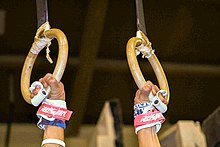Rings (gymnastics)


The rings, also known as steady rings or still rings[1] (in contrast to flying rings), is an artistic gymnastics apparatus and the event that uses it. It is traditionally used only by male gymnasts, due to its extreme upper-body strength requirements. Gymnasts typically wear ring grips while performing on the rings.
The apparatus
The apparatus consists of two rings that hang freely from a rigid metal frame. Each ring is supported by a strap, which in turn connects to a steel cable that is suspended from the metal frame. The gymnast, who grips one ring with each hand, must control the movement of the rings.[1]
Dimensions
The measurements of the standard apparatus are specified by Fédération Internationale de Gymnastique (FIG) in its Apparatus Norms document:[2]
- Inner diameter: 18 centimetres (7.1 in) ± 0.1 centimetres (0.039 in)[1]
- Distance from point of attachment to lower inner side of the rings: 300 centimetres (9.8 ft) ± 1 centimetre (0.39 in)[1]
- Distance between two points of attachment: 50 centimetres (1.6 ft) ± 0.5 centimetres (0.20 in)[1]
Routines
An exercise on rings consists of swing, strength and hold elements. Generally, gymnasts are required to fulfill various requirements including a swing to held handstand, a static strength hold, and an aerial dismount. More experienced gymnasts will often perform more than one strength element, sometimes swinging into hold positions or consecutively performing different holds.[3]
One of the most widely recognized skills performed on the rings is the Iron Cross, which is executed by extending both arms straight out from the sides of the body while suspended mid air for at least two seconds. Other common strength moves include the inverted cross (i.e., vertically inverted Iron Cross) and the Maltese cross, in which the gymnast holds his body parallel to the ground at ring height with arms extended laterally. Swing elements include giant swings from handstand to handstand, similar to giants performed on the horizontal bar. Elements on the rings are regulated by the Code of Points.
International level routines
A rings routine should contain at least one element from all element groups:
- I. Kip and swing elements (including to L-sit)
- II. Swings to handstand
- III. Swings to strength hold elements (not L-sits)
- IV. Strength elements and hold elements
- V. Dismounts
Scoring and rules
Gymnasts will take deductions for form similar to other apparatus. On rings gymnasts will also take deductions for having bent arms in strength elements, or using the straps/cables to support or balance themselves. There are also deductions for excessive swinging of the cables during the routine.
Gymnasts who specialise in the rings discipline
- Albert Azaryan
- Akinori Nakayama
- Jury Chechi
- Yordan Yovchev
- Chen Yibing
- Arthur Zanetti
- Yuri Van Gelder
Other uses
Aside from their primary use in men's gymnastics, rings are sometimes used by both men and women in various fitness regimens.
References
- ^ a b c d e Tyagi, Arun Kumar (2010). Gymnastics Skills and Rules. Pinnacle Technology. ISBN 978-1618200334.
{{cite book}}:|access-date=requires|url=(help) - ^ "Apparatus Norms" (PDF). Fédération Internationale de Gymnastique. 2011. Retrieved 23 May 2013.
- ^ Readhead, Lioyd. A World-Class Gymnast (illustrated ed.). Heinemann-Raintree Library. ISBN 978-1403446725.
{{cite book}}:|access-date=requires|url=(help)
